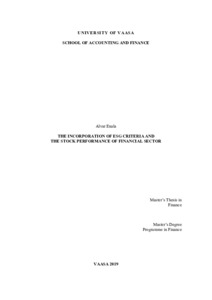The Incorporation of ESG Criteria and the Stock Performance of Financial Sector
Enala, Alvar (2020-01-20)
Enala, Alvar
20.01.2020
Julkaisun pysyvä osoite on
https://urn.fi/URN:NBN:fi-fe202001202763
https://urn.fi/URN:NBN:fi-fe202001202763
Tiivistelmä
A substantial amount of academic research argue that there is an anomaly between high ESG scored companies and financial performance, yet many academics also reject such a view. Thus, this thesis investigates whether the incorporation of high ESG criteria leads to abnormal stock performance in the financial sector. The thesis uses ESG and financial data obtained from the Thomson Reuters ASSET4 database and factor data obtained from Kenneth R. French’s web page. The data sample consists of 193 financial companies, divided into banks and financial services companies, that are or were listed in the NYSE between 2002 and 2017. Financial sector is of interest due to its troublesome reputation in corporate responsibility and ethics altogether.
The thesis employs three different asset pricing models in order to minimize the impression of p-hacking and thereby investigate whether financial companies with higher ESG scores overperform, underperform, or does neither when compared to a risk-free investment. These are asset pricing models are the CAPM, the Fama and French (1993) three-factor model, and the Fama and French (2015) five-factor model. The regression analyses is divided into two separate sample periods: the first sample covers the whole data period, whereas the post-crisis period is covering the more recent years during which the ESG phenomenon has emerged significantly. The thesis makes use of the best-in- class (worst-in-class) approach by screening 20% of the best (worst) ranked financial companies by their individual or combined ESG criteria.
The thesis finds evidence that incorporating higher ESG criteria leads to either negative abnormal stock returns or does not have an effect at all. According to the OLS regression results obtained with the Fama and French three-factor model, the top financial companies ranked by their “Environmental” scores, generate annual alpha of -5.94% over the whole sample, whereas the top financial companies ranked by their “Governance” scores generate annual alpha of -4.66%. This indicates that the high ESG scored financial companies underperform the risk-free investment. Furthermore, the CAPM and the Fama and French five-factor models provide statistically insignificant alphas, therefore indicating that high ESG scored financial companies neither under- or overperform.
The thesis employs three different asset pricing models in order to minimize the impression of p-hacking and thereby investigate whether financial companies with higher ESG scores overperform, underperform, or does neither when compared to a risk-free investment. These are asset pricing models are the CAPM, the Fama and French (1993) three-factor model, and the Fama and French (2015) five-factor model. The regression analyses is divided into two separate sample periods: the first sample covers the whole data period, whereas the post-crisis period is covering the more recent years during which the ESG phenomenon has emerged significantly. The thesis makes use of the best-in- class (worst-in-class) approach by screening 20% of the best (worst) ranked financial companies by their individual or combined ESG criteria.
The thesis finds evidence that incorporating higher ESG criteria leads to either negative abnormal stock returns or does not have an effect at all. According to the OLS regression results obtained with the Fama and French three-factor model, the top financial companies ranked by their “Environmental” scores, generate annual alpha of -5.94% over the whole sample, whereas the top financial companies ranked by their “Governance” scores generate annual alpha of -4.66%. This indicates that the high ESG scored financial companies underperform the risk-free investment. Furthermore, the CAPM and the Fama and French five-factor models provide statistically insignificant alphas, therefore indicating that high ESG scored financial companies neither under- or overperform.
